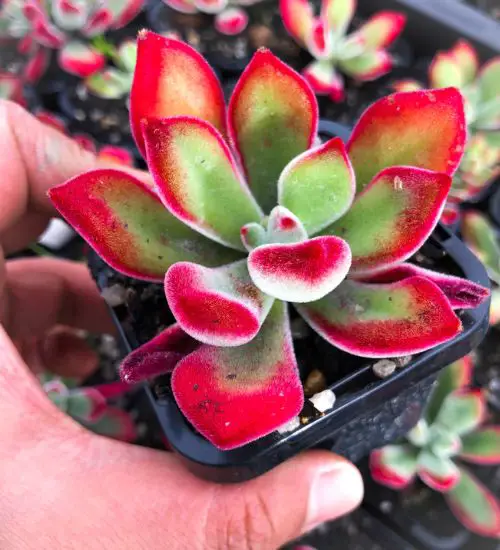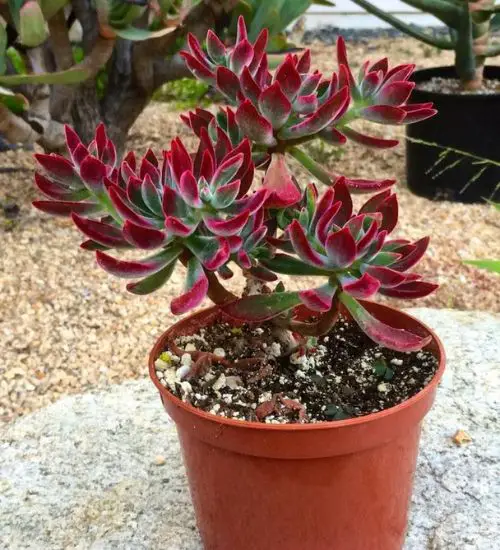Sun: full sun to partial shade
Water: Typical water needs for a succulent
Temperature: Zone 9b from 25° F to 30° F (-3.9° C to -1.1° C) to Zone 11b from 45° F to 50° F (7.2° C to 10° C)
Winter Survival: Not cold hardy
Propagation: leaves, offsets, seeds
Flower: in late winter or early spring
Flower Type: Yellow, Orange
Toxic: Generally non-toxic to humans and animals
Dormant: winter
Space Requirement: Indoors & Outdoors
Common Problems: Fungal diseases, pests
Where to buy Echeveria pulvinata 'Ruby'?
Basc Care for Echeveria pulvinata 'Ruby'
Watering
What you need to remember is that this type of succulents needs to be watered for every 2 weeks
One simple tip for you is that you can use some online apps to check the soil status before you go water your succulents. I would recommend the ThePlantsCheck app, it has some nice features there.
Fertilizing
Only feed this succulent during its active growing seasons which means winter. Use the right fertilizer applied in the right amounts. Applying half-strength balanced fertilizer every month or so is recommended for optimal results.
Do not fertilize during winter as the plant is dormant.
Sun & Location Requirements for "Chenille Plant or Plush Plant."
Echeveria pulvinata 'Ruby' requires full sun to partial shade in order to stay healthy and vibrant. Always keep an eye on the temperatures and light levels as too much direct sunlight can be damaging to this type of succulent. If you notice any signs of distress, try moving it to a shadier spot within your garden or home.
As per this succulent profile, it is only able to stay healthy when the environment temperature is above the range of zone 9b from 25° F to 30° F (-3.9° C to -1.1° C).
When temperatures drop below freezing, it is important to take precautions to protect Echeveria pulvinata 'Ruby' from the cold. Insulating and providing adequate drainage for the plant are key elements in helping it survive winter weather. Wind and sun exposure should also be minimized to prevent frost damage.
Any succulents in the group will need a medium space to grow. You can place your pot at your table or window. Since this plant needs more space than mini succulents, you should consider do not plant them together with other succulents/plants.
Echeveria pulvinata 'Ruby' also benefits from some indirect light throughout the day as well, so make sure you give it enough space to soak up light without becoming too exposed to heat.
Propagation
Propagating succulents from leaves is an easy and cost-effective way to grow new plants. All you need are a few healthy leaves from the mother plant, some potting mix, and regular watering. After a few weeks you'll have brand new succulents that you can watch grow!
One way to propagate Echeveria pulvinata 'Ruby' is by offsets. Taking an offset from the mother plant and potting it into soil will give you a brand new succulent with minimal effort.
Echeveria pulvinata 'Ruby' propagates easily from seeds, however it's important to look for healthy ones which are plump, dark in color and slightly sticky when touched. To start the propagation process, mix a soil mixture with well-draining potting mix then sow the seeds evenly and press them lightly into the surface. Finally, water the soil using a spray bottle and place it in bright but indirect light to ensure germination.
Toxicity

Echeveria pulvinata 'Ruby' is not known to pose any significant health risks, as it is not considered to be toxic. However, it is best to keep the plant away from young children and pets, as they may ingest some of the parts of this plant that could contain toxins which can cause mild skin irritation.
Pests and Diseases
Echeveria pulvinata 'Ruby' can be affected common pests and diseases like most of the other succulents such as mealybugs and scale insects.
If you do spot any of pest signs, you can treat your succulent using below methods.
- Mealybugs: quarantine, clean infected plants, soapy water.
- Scale insects: quarantine, clean infected plants, soapy water.
Besides that, to prevent serious health issues from happening, keep your succulent in a well-ventilated area and check it regularly for any signs of pests or health problems.


